Controlled Cationic Polymerization of p-Methylstyrene in Ionic Liquid and Its Mechanism
Abstract
:1. Introduction
2. Experimental Section
2.1. Materials
2.2. Polymerization
2.3. Measurements
2.4. Computational Method
3. Results and Discussion
3.1. Screening of the IL Solvent Suitable for Cationic Polymerization
3.2. Effects of the p-MeStCl/SnCl4 Initiating System
3.3. The Specialties of IL: Ionic Nature and High Polarity
3.4. Mild Reaction Rate and Heat-Release Rate
3.5. Effects of Lewis Acid Concentration on p-MeSt Polymerization in ILs
3.6. Effects of DTBP Concentration on p-MeSt Polymerization in ILs
3.7. The Controllability of p-MeSt Cationic Polymerization in ILs
3.8. Mechanism of p-MeSt Cationic Polymerization in ILs by p-MeStCl/SnCl4
4. Conclusions
Author Contributions
Funding
Institutional Review Board Statement
Informed Consent Statement
Data Availability Statement
Conflicts of Interest
References
- Mallakpour, S.; Rafiee, Z. Ionic liquids as environmentally friendly solvents in macromolecules chemistry and technology, Part I. J. Polym. Environ. 2011, 19, 447–484. [Google Scholar] [CrossRef]
- Kubisa, P. Ionic liquids as solvents for polymerization processes—Progress and challenges. Prog. Polym. Sci. 2009, 34, 1333–1347. [Google Scholar] [CrossRef]
- Mohammad, A. Green Solvents II: Properties and Applications of Ionic Liquids; Springer: Berlin/Heidelberg, Germany, 2012. [Google Scholar]
- Meine, N.; Benedito, F.; Rinaldi, R. Thermal stability of ionic liquids assessed by potentiometric titration. Green Chem. 2010, 12, 1711–1714. [Google Scholar] [CrossRef]
- Zhao, D. Advances of polymerization in room temperature ionic liquids. Prog. Chem. 2005, 17, 700–705. [Google Scholar]
- Kubisa, P. Application of ionic liquids as solvents for polymerization processes. Prog. Polym. Sci. 2004, 29, 3–12. [Google Scholar] [CrossRef]
- Zhang, X.; Guo, W.; Wu, Y.; Li, W.; Li, S.; Shang, Y.; Zhang, J. Solubility of monomers for chain polymerization in ionic liquids predicted by the conductor-like screening model for real solvents. Ind. Eng. Chem. Res. 2017, 56, 14694–14703. [Google Scholar] [CrossRef]
- Lessan, F.; Foudazi, R. Effect of [EMIM][BF4] ionic liquid on the properties of ultrafiltration membranes. Polymer 2020, 210, 122977. [Google Scholar] [CrossRef]
- Ferrari, F.A.; Nogueira, G.P.; Franco, T.T.; Dias, M.; Cavaliero, C.; Witkamp, G.J.; Wielen, L.; Forte, M. The role of ionic liquid pretreatment and recycling design in the sustainability of a biorefinery: A sugarcane to ethanol example. Green Chem. 2021, 23, 9126–9139. [Google Scholar] [CrossRef]
- Loureno, T.C.; Barros, L.M.S.; Anchieta, C.G.; Nepel, T.C.M.; Julia, J.P.O.; Dias, L.G.; Filho, R.M.; Doubek, G.; Silva, J.L.F.D. Tuning aprotic solvent properties with long alkyl chain ionic liquid for lithium-based electrolytes. J. Mater. Chem. A 2022, 10, 11684–11701. [Google Scholar] [CrossRef]
- Zhou, Y.; Zhang, X.; Yin, D.; Zhang, J.; Mi, Q.; Lu, H.; Liang, D.; Zhang, J. The solution state and dissolution process of cellulose in ionic-liquid-based solvents with different hydrogen-bonding basicity and microstructures. Green Chem. 2022, 24, 3824–3833. [Google Scholar] [CrossRef]
- Wu, G.; Wu, Y. Control Cationic Polymerization and Its Application; Chemical Industry Press: Beijing, China, 2005. [Google Scholar]
- Li, X.; Wu, Y.; Zhang, J.; Li, S.; Min, Z.; Dan, Y.; Hao, W.; Shang, Y.; Guo, W.; Yan, P. Synthesis of highly reactive polyisobutylenes via cationic polymerization in ionic liquids: Characteristics and mechanism. Polym. Chem. 2018, 10, 201–208. [Google Scholar] [CrossRef]
- Higashimura, T.; Ishihama, Y.; Sawamoto, M. Living cationic polymerization of styrene: New initiating systems based on added halide salts and the nature of the growing species. Macromolecules 1993, 26, 744–751. [Google Scholar] [CrossRef]
- Sigwalt, P.; Moreau, M. Carbocationic polymerization: Mechanisms and kinetics of propagation reactions. Prog. Polym. Sci. 2006, 31, 44–120. [Google Scholar] [CrossRef]
- Wu, Y.; Han, L.; Zhang, X.; Mao, J.; Gong, L.; Guo, W.; Gu, K.; Li, S. Cationic polymerization of isobutyl vinyl ether in an imidazole-based ionic liquid: Characteristics and mechanism. Polym. Chem. 2015, 6, 2560–2568. [Google Scholar] [CrossRef]
- Jiang, J.; Wang, S.; Kong, Y.; Yan, W.; Li, J. Well-defined core-shell nanostructural block copolymer supported recyclable bronsted acidic ionic liquid catalyst for the synthesis of biodiesel. Eur. Polym. J. 2020, 140, 109922. [Google Scholar] [CrossRef]
- Brusseau, S.g.n.; Boyron, O.; Schikaneder, C.; Santini, C.C.; Charleux, B. Nitroxide-mediated controlled/living radical copolymerization of methyl methacrylate with a low amount of styrene in ionic liquid. Macromolecules 2011, 44, 215–220. [Google Scholar] [CrossRef]
- Anastasaki, A.; Nikolaou, V.; Nurumbetov, G.; Truong, N.P.; Pappas, G.S.; Engelis, N.G.; Quinn, J.F.; Whittaker, M.R.; Davis, T.P.; Haddleton, D.M. Synthesis of well-defined poly(acrylates) in ionic liquids via copper(II)-mediated photoinduced living radical polymerization. Macromolecules 2015, 48, 5140–5147. [Google Scholar] [CrossRef]
- Kubisa, P. Kinetics of radical polymerization in ionic liquids. Eur. Polym. J. 2020, 133, 109778. [Google Scholar] [CrossRef]
- Hsu, S.Y.; Ohno, K.; Sakakibara, K.; Tsujii, Y. Convenient synthesis of very-thick concentrated polymer brushes by atom transfer radical polymerization in an ionic liquid. Macromolecules 2020, 53, 7936–7943. [Google Scholar] [CrossRef]
- Zhang, S.; Dias Goncalves, L.; Lefebvre, H.; Tessier, M.; Rousseau, B.; Fradet, A. Direct poly(β-alanine) synthesis via polycondensation in ionic liquids. ACS Macro Lett. 2012, 1, 1079–1082. [Google Scholar] [CrossRef]
- Lozinskaya, E.I.; Shaplov, A.S.; Vygodskii, Y.S. Direct polycondensation in ionic liquids. Eur. Polym. J. 2004, 40, 2065–2075. [Google Scholar] [CrossRef]
- Maniar, D.; Silvianti, F.; Ospina, V.M.; Woortman, A.; Loos, K. On the way to greener furanic-aliphatic poly(ester amide)s: Enzymatic polymerization in ionic liquid. Polymer 2020, 205, 122662. [Google Scholar] [CrossRef]
- Peng, Q.; Wei, L.; Zhang, X.; Wu, Y.; Mahmood, K.; Liu, Z.; Zhang, L. Direct polycondensation of l-lactic acid in hydrophobic bis(trifluoromethanesulfonyl)imide-anionic ionic liquids: A kinetic study. Eur. Polym. J. 2021, 158, 110692. [Google Scholar] [CrossRef]
- Berezianko, I.A.; Vasilenko, I.V.; Kostjuk, S.V. Cationic polymerization of isobutylene co-initiated by chloroferrate imidazole-based ionic liquid: The advantageous effect of initiator and aromatic compounds. Eur. Polym. J. 2019, 121, 109307. [Google Scholar] [CrossRef]
- Feng, Y.; Yang, J.; Zheng, K.; Stansbury, J.W.; Nie, J. Electro-induced cationic polymerization of vinyl ethers by using ionic liquid 1-butyl-3-methy limidazolium tetrafluoroborate as initiator. Macromol. Chem. Phys. 2015, 216, 380–385. [Google Scholar]
- Dutra, G.; Silv Rio, W.; Ara Jo, P.; Sayer, C.; Silveira, B.; Machado, F. Cationic polymerization of styrene using iron-containing ionic liquid catalysts in an aqueous dispersed medium. Polímeros 2021, 31, e2021005. [Google Scholar] [CrossRef]
- Huddleston, J.G.; Visser, A.E.; Reichert, W.M.; Willauer, H.D.; Broker, G.A.; Rogers, R.D. Characterization and comparison of hydrophilic and hydrophobic room temperature ionic liquids incorporating the imidazolium cation. Green Chem. 2001, 3, 156–164. [Google Scholar] [CrossRef]
- Kokubo, H.; Watanabe, M. Anionic polymerization of methyl methacrylate in an ionic liquid. Polym. Adv. Technol. 2008, 19, 1441–1444. [Google Scholar] [CrossRef]
- Biedroń, T.; Kubisa, P. Chain transfer to ionic liquid in an anionic polymerization of methyl methacrylate. J. Polym. Sci. Part A Polym. Chem. 2007, 45, 4168–4172. [Google Scholar] [CrossRef]
- Vijayaraghavan, R.; MacFarlane, D. Living cationic polymerisation of styrene in an ionic liquid. Chem. Commun. 2004, 6, 700–701. [Google Scholar] [CrossRef] [PubMed]
- Vijayaraghavan, R.; MacFarlane, D.R. Organoborate acide as initiators for cationic polymerization of styrene in an ionic liquid medium. Macromolecules 2007, 40, 6515–6520. [Google Scholar] [CrossRef]
- Basśko, M.; Biedronń, T.; Kubisa, P. Cationic polymerization of styrene involving ionization of the C-Cl bond in ionic liquid/SO2 mixture. J. Polym. Sci. Part A Polym. Chem. 2009, 47, 5251–5257. [Google Scholar] [CrossRef]
- Yoshimitsu, H.; Kanazawa, A.; Kanaoka, S.; Aoshima, S. Cationic polymerization of vinyl ethers with alkyl or ionic side groups in ionic liquids. J. Polym. Sci. Part A Polym. Chem. 2016, 54, 1774–1784. [Google Scholar] [CrossRef]
- MacFarlane, D.R.; Pringle, J.M.; Johansson, K.M.; Forsyth, S.A.; Forsyth, M. Lewis base ionic liquids. Chem. Commun. 2006, 18, 1905–1917. [Google Scholar] [CrossRef] [PubMed]
- Zhang, X.; Guo, W.; Wu, Y.; Gong, L.; Li, W.; Li, X.; Li, S.; Shang, Y.; Yang, D.; Wang, H. Cationic polymerization of p-methylstyrene in selected ionic liquids and polymerization mechanism. Polym. Chem. 2016, 7, 5099–5112. [Google Scholar] [CrossRef]
- Hadjikyriacou, S.; Acar, M.; Faust, R. Living and controlled polymerization of isobutylene with alkylaluminum halides as coinitiators. Macromolecules 2004, 37, 7543–7547. [Google Scholar] [CrossRef]
- De, P.; Faust, R. Determination of the absolute rate constant of propagation for ion pairs in the cationic polymerization of p-methylstyrene. Macromolecules 2005, 38, 5498–5505. [Google Scholar] [CrossRef]
- Vasilenko, I.V.; Berezianko, I.A.; Shiman, D.I.; Kostjuk, S.V. New catalysts for the synthesis of highly reactive polyisobutylene: Chloroaluminate imidazole-based ionic liquids in the presence of diisopropyl ether. Polym. Chem. 2016, 7, 5615–5619. [Google Scholar] [CrossRef]
- Kojima, K.; Sawamoto, M.; Higashimura, T. Living cationic polymerization of p-methylstyrene by hydrogen iodide/zinc halide initiating systems. J. Polym. Sci. Part A Polym. Chem. 1990, 28, 3007–3017. [Google Scholar] [CrossRef]
- Banerjee, S.; Paira, T.K.; Kotal, A.; Mandal, T.K. Room temperature living cationic polymerization of styrene with HX-styrenic monomer adduct/FeCl3 systems in the presence of tetrabutylammonium halide and tetraalkylphosphonium bromide salts. Polymer 2010, 51, 1258–1269. [Google Scholar] [CrossRef]
- Lutz, J.-F.; Matyjaszewski, K. Nuclear magnetic resonance monitoring of chain-end functionality in the atom transfer radical polymerization of styrene. J. Polym. Sci. Part A Polym.Chem. 2005, 43, 897–910. [Google Scholar] [CrossRef]
- Vasilenko, I.V.; Kostjuk, S.V.; Kaputsky, F.N.; Nedorezova, P.M.; Aladyshev, A.M. Effect of Different Aluminum Alkyls on the Metallocene/Methylaluminoxane Catalyzed Polymerization of Higher α-Olefins and Styrene. Macromol. Chem. Phys. 2008, 209, 1255–1265. [Google Scholar] [CrossRef]
- Kostjuk, S.V.; Radchenko, A.V.; Ganachaud, F. Controlled/living cationic polymerization of p-methoxystyrene in solution and aqueous dispersion using tris (pentafluorophenyl) borane as a lewis acid: Acetonitrile does the job. Macromolecules 2007, 40, 482–490. [Google Scholar] [CrossRef]
- Tanizaki, A.; Sawamoto, M.; Higashimura, T. Cationic polymerization of p-methylstyrene initiated by acetyl perchlorate: An approach to living polymerization. J. Polym. Sci. Part A Polym. Chem. 1986, 24, 87–96. [Google Scholar] [CrossRef]
- Reichardt, C. Polarity of ionic liquids determined empirically by means of solvatochromic pyridinium N-phenolate betaine dyes. Green Chem. 2005, 7, 339–351. [Google Scholar] [CrossRef]
- Kier, L.B. Quantitation of solvent polarity based on molecular structure. J. pharm. Sci. 1981, 70, 930–933. [Google Scholar] [CrossRef]
- Zou, J.; Yu, Q.; Shang, Z. Correlation between empirical solvent polarity scales and computed quantities derived from molecular surface electrostatic potentials. J. Chem. Soc. Perkin Trans. 2001, 2, 1439–1443. [Google Scholar] [CrossRef]
- Jessop, P.G.; Jessop, D.A.; Fu, D.; Phan, L. Solvatochromic parameters for solvents of interest in green chemistry. Green Chem. 2012, 14, 1245–1259. [Google Scholar] [CrossRef]
- Bennevault, V.; Peruch, F.; Deffieux, A. Influence of various proton traps on the bifunctional cationic polymerization of chloroethyl vinyl ether mediated by α-iodo ether/zinc dichloride. Macromol. Chem. Phys. 1996, 197, 2603–2613. [Google Scholar] [CrossRef]
- De, P.; Faust, R. Living carbocationic polymerization of p-methoxystyrene using p-methoxystyrene hydrochloride/SnBr4 initiating system: Determination of the absolute rate constant of propagation for ion pairs. Macromolecules 2004, 37, 7930–7937. [Google Scholar] [CrossRef]
- Storey, R.F.; Curry, C.L.; Hendry, L.K. Mechanistic role of lewis bases and other additives in quasiliving carbocationic polymerization of isobutylene. Macromolecules 2001, 34, 5416–5432. [Google Scholar] [CrossRef]
- Satoh, K.; Nakashima, J.; Kamigaito, M.; Sawamoto, M. Novel BF3OEt2/R−OH initiating system for controlled cationic polymerization of styrene in the presence of water. Macromolecules 2001, 34, 396–401. [Google Scholar] [CrossRef]
- Zhang, X.; Zhou, X.; Sun, Y.; Yue, L.; Shi, Y.; Xu, K.; Luo, Z.; Wu, Y. Cationic polymerization of p-methylstyrene in ionic lquids media. Acta Polym. Sin. 2019, 50, 375–383. [Google Scholar]
- Katayama, H.; Kitaguchi, H.; Kamigaito, M.; Sawamoto, M. Matrix-assisted laser desorption ionization time of flight mass spectrometry analysis of living cationic polymerization of vinyl ethers. I. Optimization of measurement conditions for poly (isobutyl vinyl ether). J. Polym. Sci. Part A Polym. Chem. 2000, 38, 4023–4031. [Google Scholar] [CrossRef]
- Satoh, K.; Kamigaito, M.; Sawamoto, M. Controlled cationic polymerization of p-methoxystyrene in aqueous media with Yb(OTf)3 1. Macromolecules 1999, 32, 3827–3832. [Google Scholar] [CrossRef]
- Satoh, K.; Kamigaito, M.; Sawamoto, M. Direct synthesis of amphiphilic random and block copolymers of p-hydroxystyrene and p-methoxystyrene via living cationic polymerization with BF3OEt2/ROH systems 1. Macromolecules 2000, 33, 5830–5835. [Google Scholar] [CrossRef]
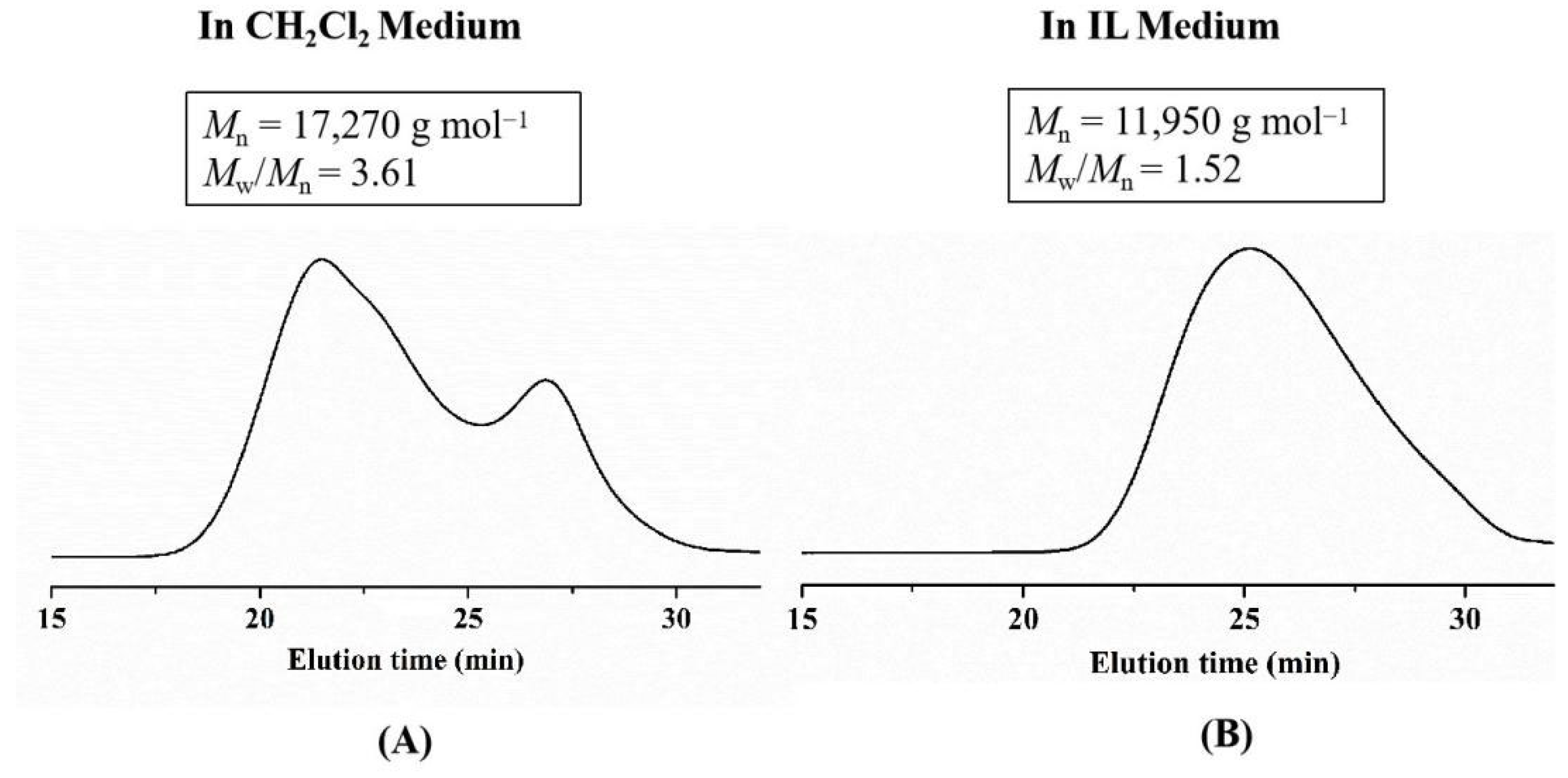
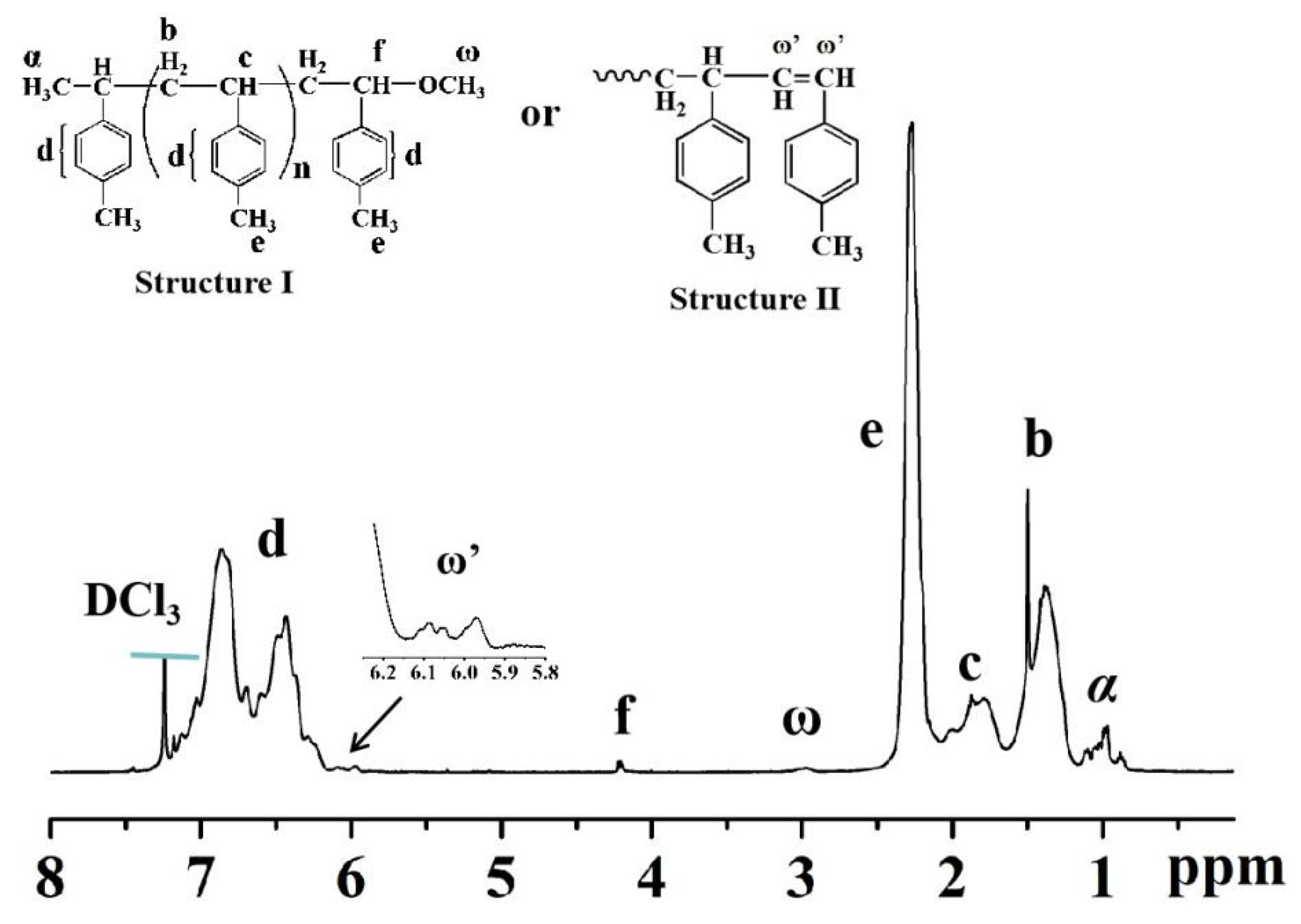
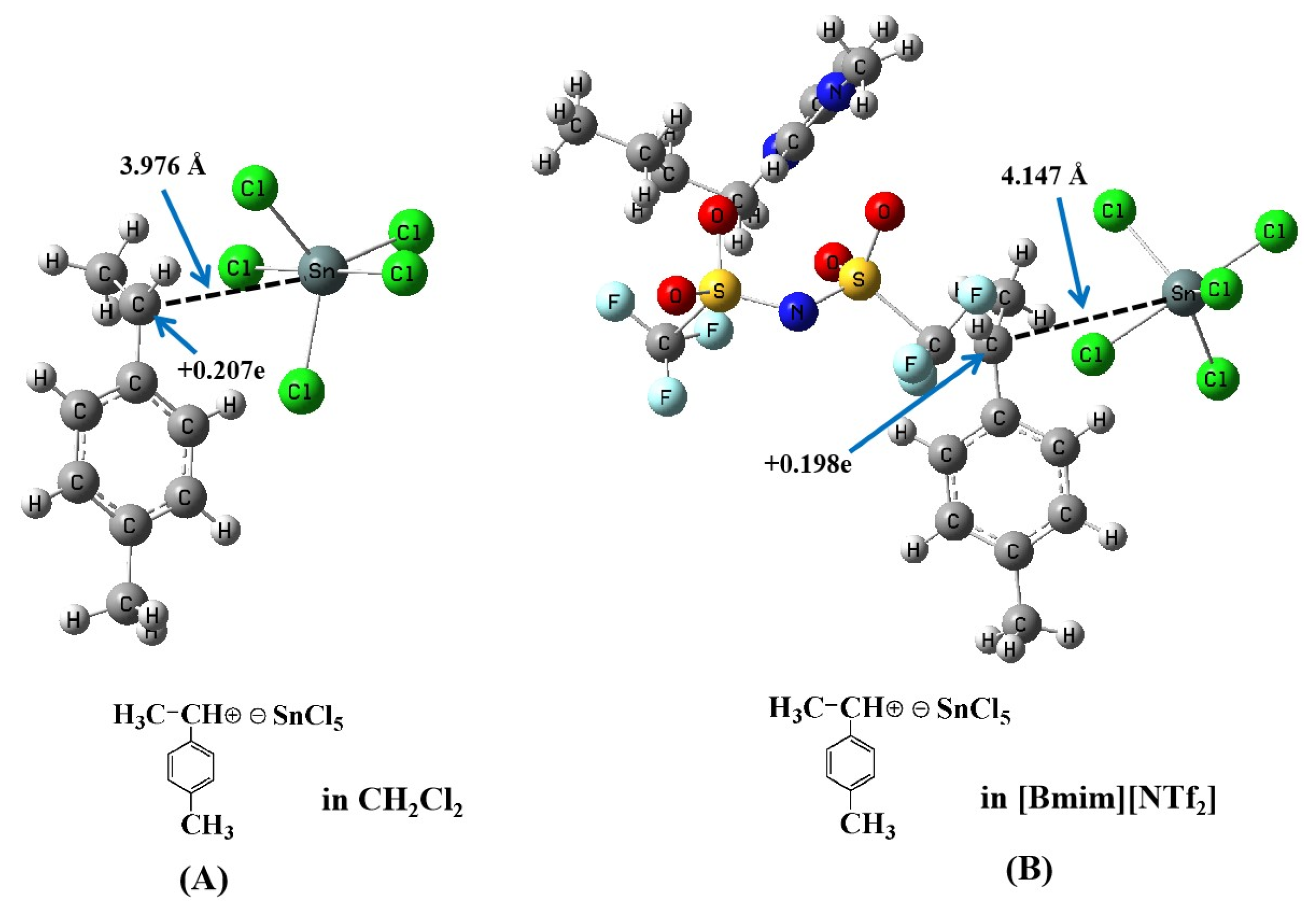


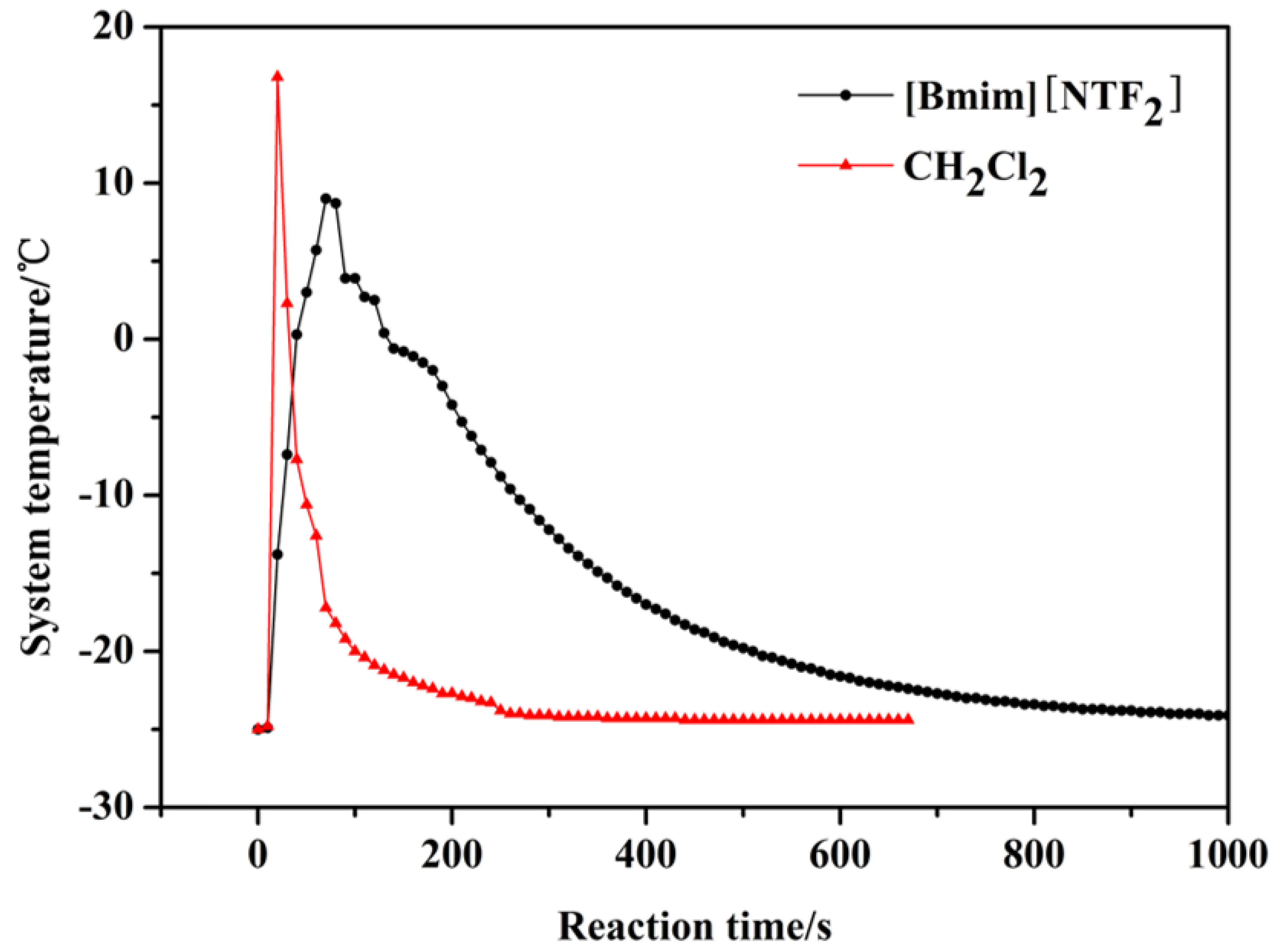
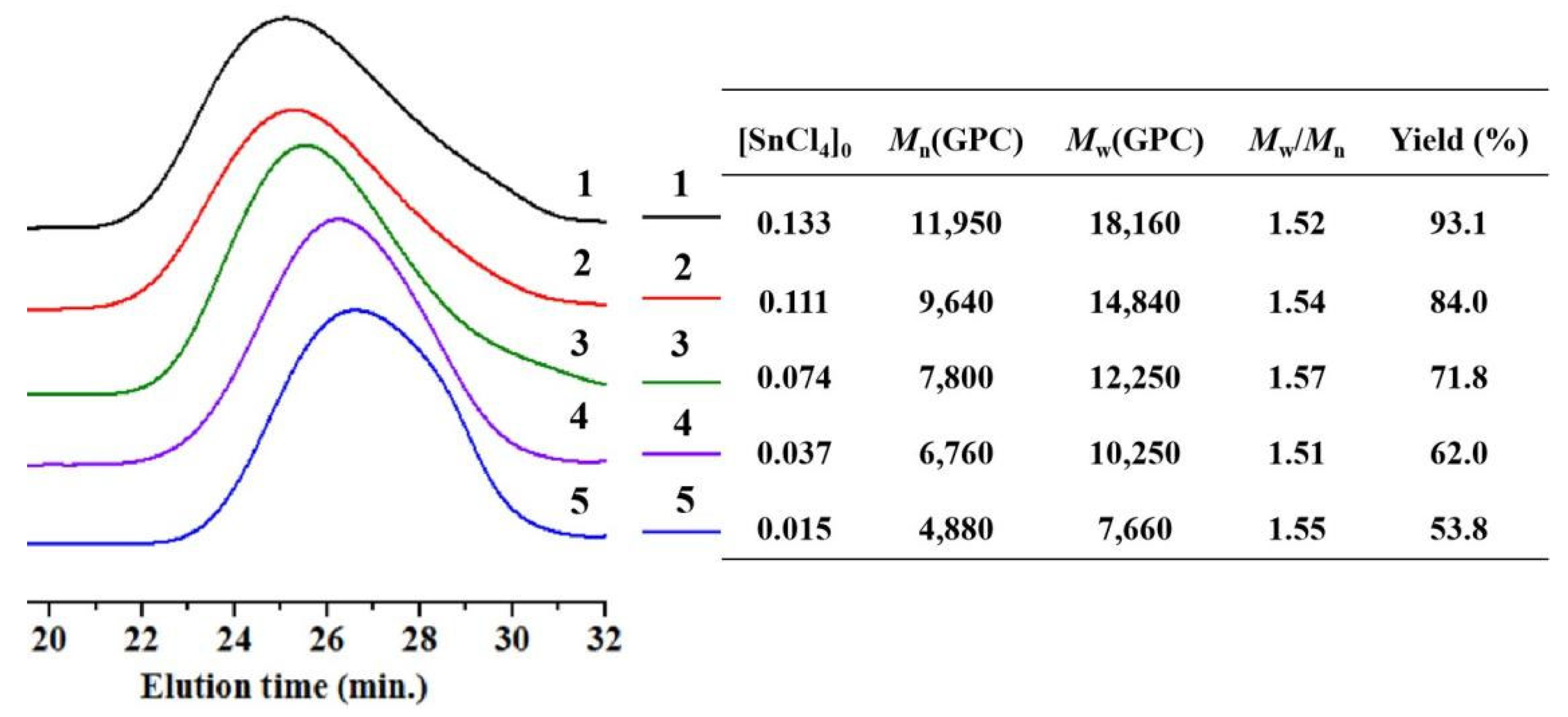
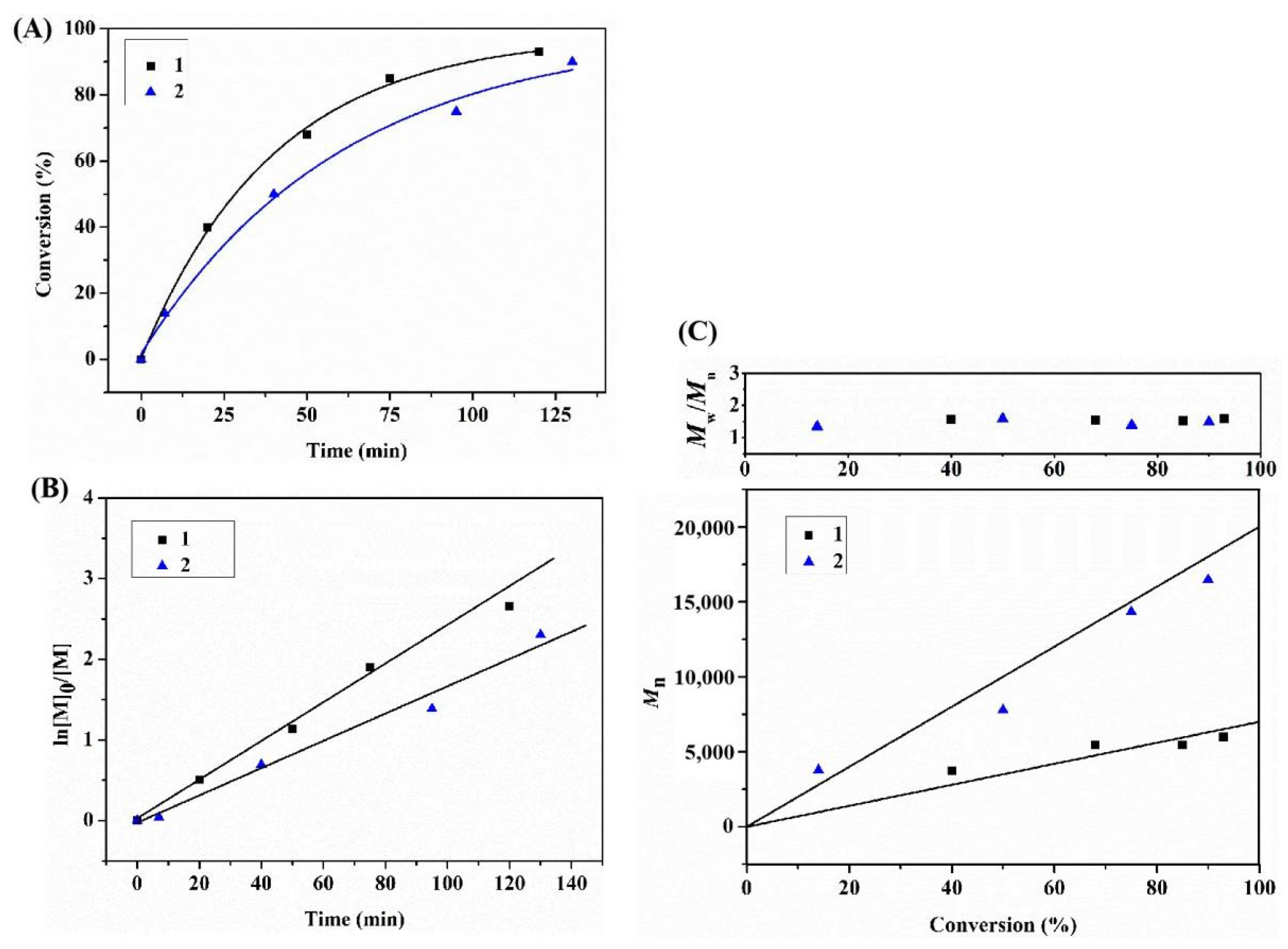
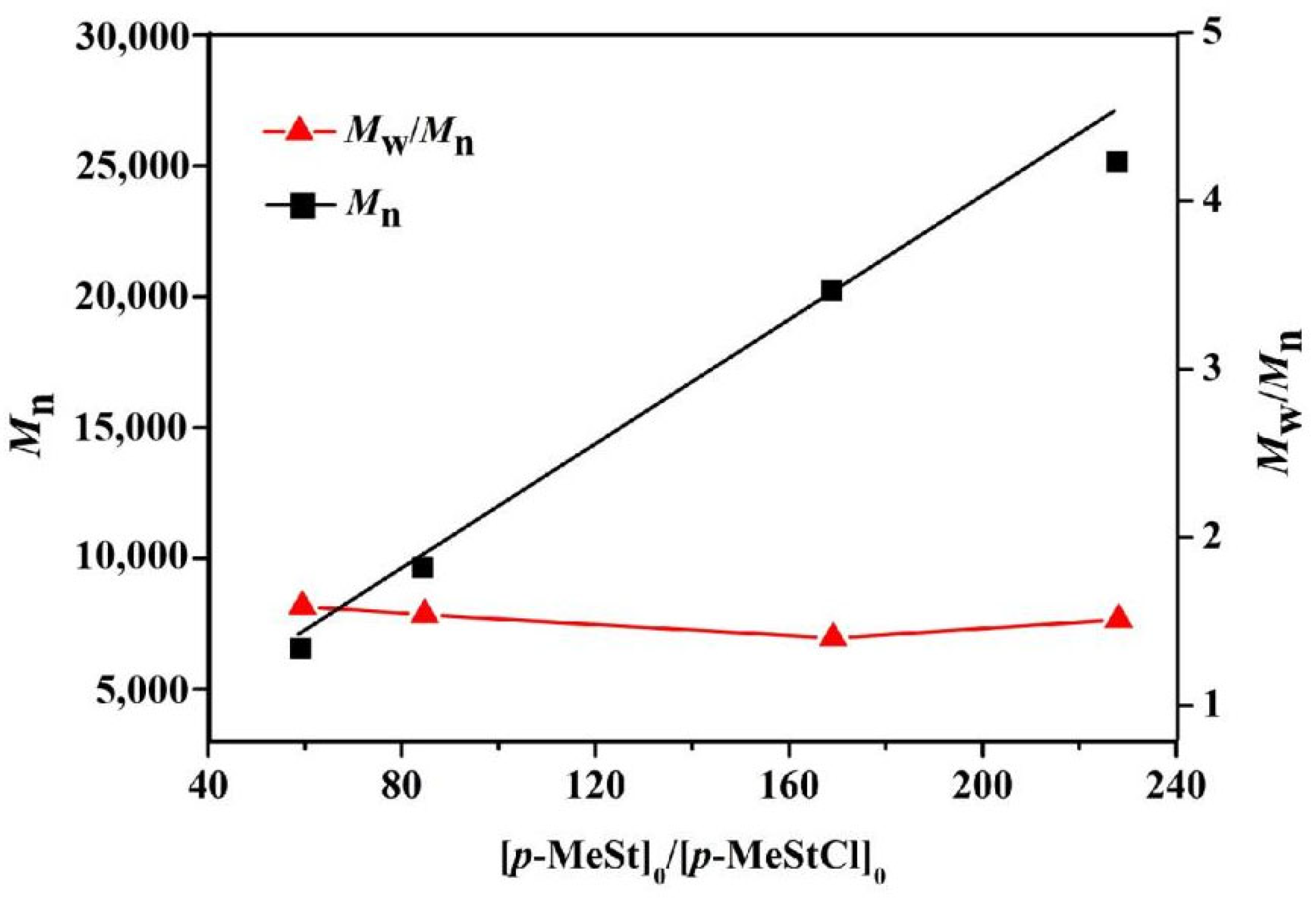
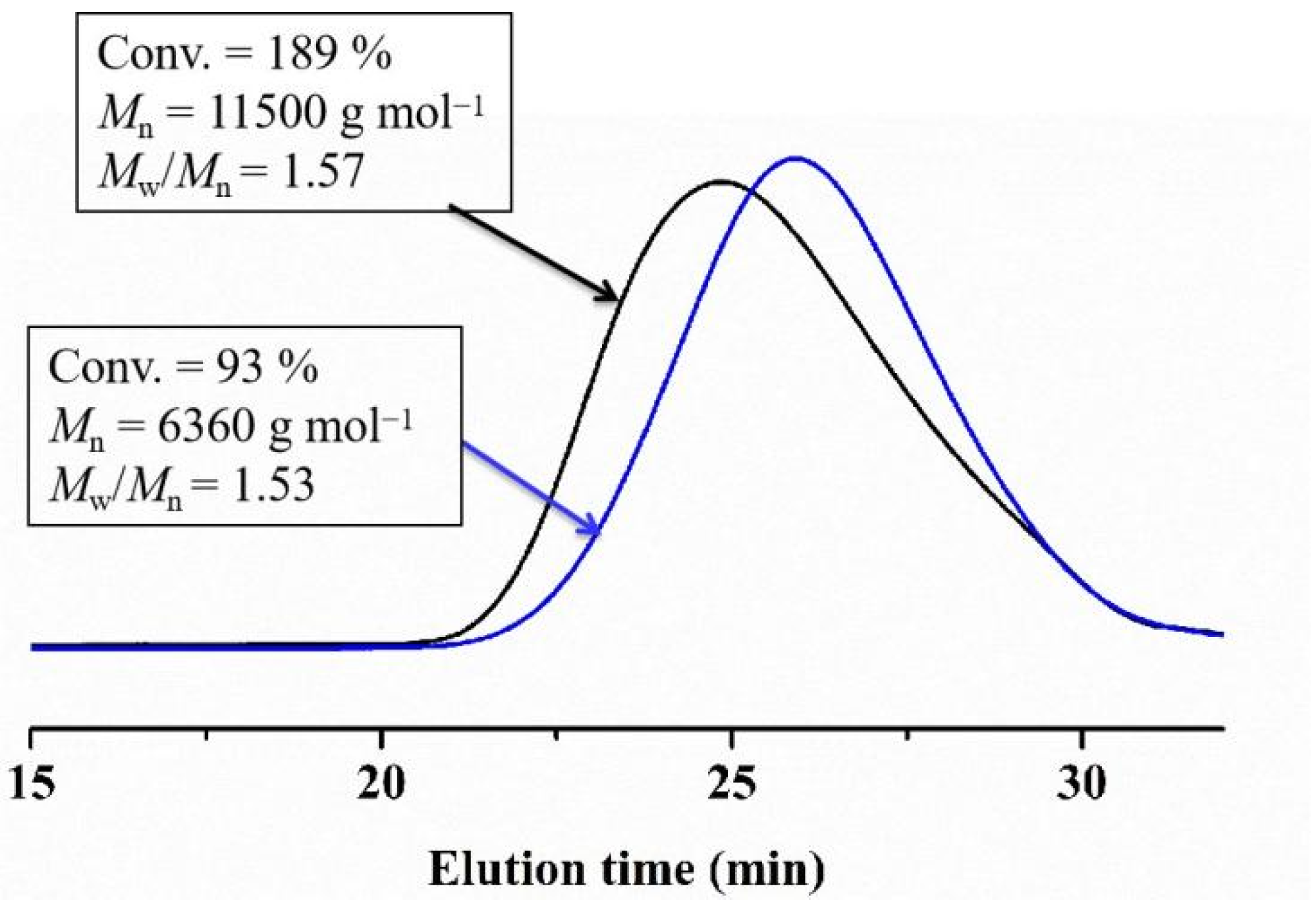

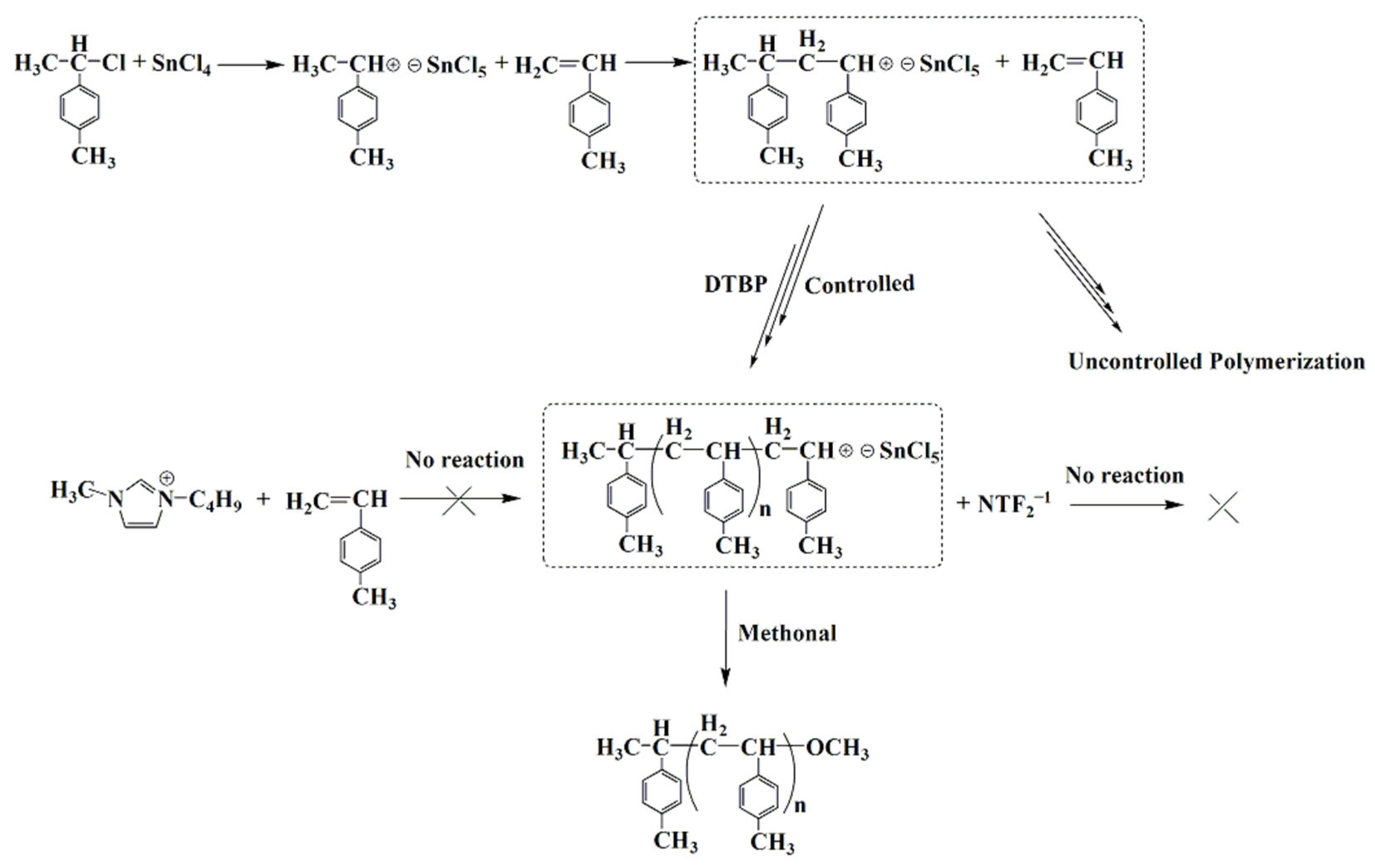
| Run | Ionic Liquids | Viscosity1 of ILs/CP | Viscosity2 of 25% (v/v) p-MeSt in ILs | p-MeSt Solubility/wt% |
|---|---|---|---|---|
| 1 | [Bmim][NTf2] | 69 | 193 | 37.95 |
| 2 | [Omim][NTf2] | 93 | 214 | 58.75 |
| 3 | [Bmim][BF4] | 140 | 502 | 15.42 |
| 4 | [Omim][BF4] | 699 | - | - |
| 5 | [Bmim][PF6] | 366 | 765 | 15.35 |
| 6 | [Omim][PF6] | 415 | 1150 | 43.11 |
| 7 | [Emim][TA] | 35 | - | - |
| Run | Initiating System | Solvent | Mn(GPC) | Mw(GPC) | Mw/Mn | Yield (%) |
|---|---|---|---|---|---|---|
| 1 | p-MeStCl/SnCl4 | [Bmim][NTf2] | 11,950 | 18,160 | 1.52 | 93.1 |
| 2 | CH2Cl2 | 17,270 | 62,360 | 3.61 | 92.4 |
| Run | [DTBP]0 | Mn(calcd.) | Mn(GPC) | Mw(GPC) | Mw/Mn | Yield (%) |
|---|---|---|---|---|---|---|
| 1 | 0.0000 | 27,930 | 11,950 | 18,160 | 1.52 | 93.1 |
| 2 | 0.0074 | 28,200 | 18,350 | 26,610 | 1.45 | 94.0 |
| 3 | 0.0149 | 28,470 | 27,100 | 36,310 | 1.34 | 94.9 |
| 4 | 0.0223 | 18,600 | 30,010 | 39,010 | 1.30 | 62.0 |
Publisher’s Note: MDPI stays neutral with regard to jurisdictional claims in published maps and institutional affiliations. |
© 2022 by the authors. Licensee MDPI, Basel, Switzerland. This article is an open access article distributed under the terms and conditions of the Creative Commons Attribution (CC BY) license (https://creativecommons.org/licenses/by/4.0/).
Share and Cite
Zhang, X.; Tang, S.; Gao, M.; Sun, C.; Wang, J. Controlled Cationic Polymerization of p-Methylstyrene in Ionic Liquid and Its Mechanism. Polymers 2022, 14, 3165. https://doi.org/10.3390/polym14153165
Zhang X, Tang S, Gao M, Sun C, Wang J. Controlled Cationic Polymerization of p-Methylstyrene in Ionic Liquid and Its Mechanism. Polymers. 2022; 14(15):3165. https://doi.org/10.3390/polym14153165
Chicago/Turabian StyleZhang, Xiaoqian, Shengde Tang, Ming Gao, Chunfeng Sun, and Jiasheng Wang. 2022. "Controlled Cationic Polymerization of p-Methylstyrene in Ionic Liquid and Its Mechanism" Polymers 14, no. 15: 3165. https://doi.org/10.3390/polym14153165
APA StyleZhang, X., Tang, S., Gao, M., Sun, C., & Wang, J. (2022). Controlled Cationic Polymerization of p-Methylstyrene in Ionic Liquid and Its Mechanism. Polymers, 14(15), 3165. https://doi.org/10.3390/polym14153165





